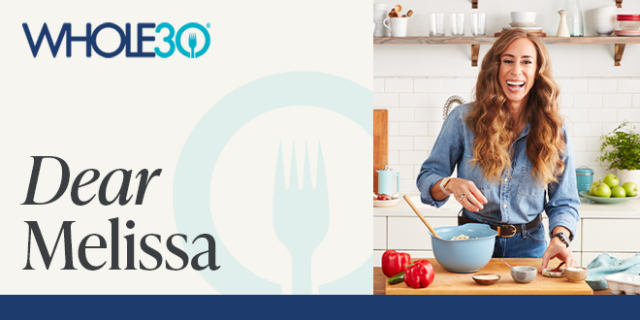Welcome to Dear Melissa, where I answer your questions about transitioning into or completing a Whole30, successfully sticking to your new healthy habits, and figuring out how to make this lifestyle work in the real world. Today, I’m talking to a woman who is fearing for her Life After Whole30, as she discovers everything she reintroduces makes her less healthy.
Dear Melissa, I started my first Whole30 on January 15, 2016. I had been trying to figure out why I was constantly having stomach pain, nausea, and occasional vomiting. After about two weeks on the program, I started feeling MUCH better. Stomach pain and nausea were gone, my skin wasn’t blotchy and bumpy, and I felt in control of my eating. Now, however, I’m struggling with re-entry. It feels like every time I try a non-Whole30 food, I get bad stomach pain—the only food that hasn’t done this is rice. I know you’re supposed to go off the Whole30 after a while, but I am now afraid to try anything off-plan. What should I do? –Kristin, Westchester, PA
Kristin,
First, I’m happy you’ve had such incredible success with the Whole30! It must have been so frustrating, not knowing what foods were contributing to your symptoms. Now that you’ve done the Whole30 and a proper reintroduction, you’re well aware of how the foods you’ve been eating are negatively impacting your digestion.
The bad news is that it sounds like lots of foods are doing that.
A few things could be happening here. Either you really are that sensitive to the foods you’ve reintroduced (gluten, dairy, non-gluten grains, soy, peanuts, beans, etc.) or you’ve got an undiagnosed gut issue (like a chronic infection or SIBO) contributing to these symptoms. Or, potentially, both.
You have a few options here. The first (and ideal) route is to work with a functional medicine practitioner to do some gut testing and make sure you don’t have a condition that needs specific treatment. If you go this route, use the resources on page 406 of The Whole30 to help you find a good doctor, and stay on your Whole30-ish diet while you’re working together, as you don’t want to complicate the diagnostic situation by eating foods you know aren’t working for you.
If you do have some kind of underlying condition, clearing that up will provide a world of benefit on top of what you’ve experienced with the Whole30, and will likely allow you to expand your daily diet to include at least some foods that are now making your stomach hurt.
If working with a healthcare practitioner isn’t in the cards right now, your second option is simply to avoid those foods you know cause unpleasant symptoms, because you’ve determined the side effects of consuming them just aren’t worth it. This means your everyday diet looks pretty Whole30-ish, with the exception of a few things (like rice, if you enjoy it) that you’ve tested and know work well for you. This should keep your symptoms at bay, and perhaps in time will heal the gut such that later reintroductions of these foods will go better. (Adding a good probiotic and/or digestive enzyme here may also help—see Probiotics 101 and Digestive Enzymes 101 for details.)
The third option is carefully experimenting with the dose, frequency, alternatives to, and variety of these foods to see if this makes a difference. For example, maybe toast with breakfast makes your stomach hurt, but you can have a slice of grain-free Paleo banana bread and still feel good. Perhaps a bowl of ice cream every night makes your stomach cramp, but you can get away with a small scoop once in a while with little to no issue. Or goat cheese didn’t go so well, but you find you can eat a small amount of fresh mozzarella or sheep’s milk cheddar without any symptoms.
The goal here is to get you to a place where you can eat the broadest diet possible while still feeling awesome. Getting there in your situation may take time, patience, and more than a few unpleasant missteps, but the good news is this: no matter what, you have a dietary plan that you know is easy to follow, totally fulfilling, and keeps all of your symptoms in check. Any time you need to, you can return to the Whole30, get yourself back to a place where you feel great, then start reintroducing again from there.
I wish you the best in health,
Melissa
For another take on this subject, see Dear Melissa: Why Can’t I Eat What My Friends Eat?















